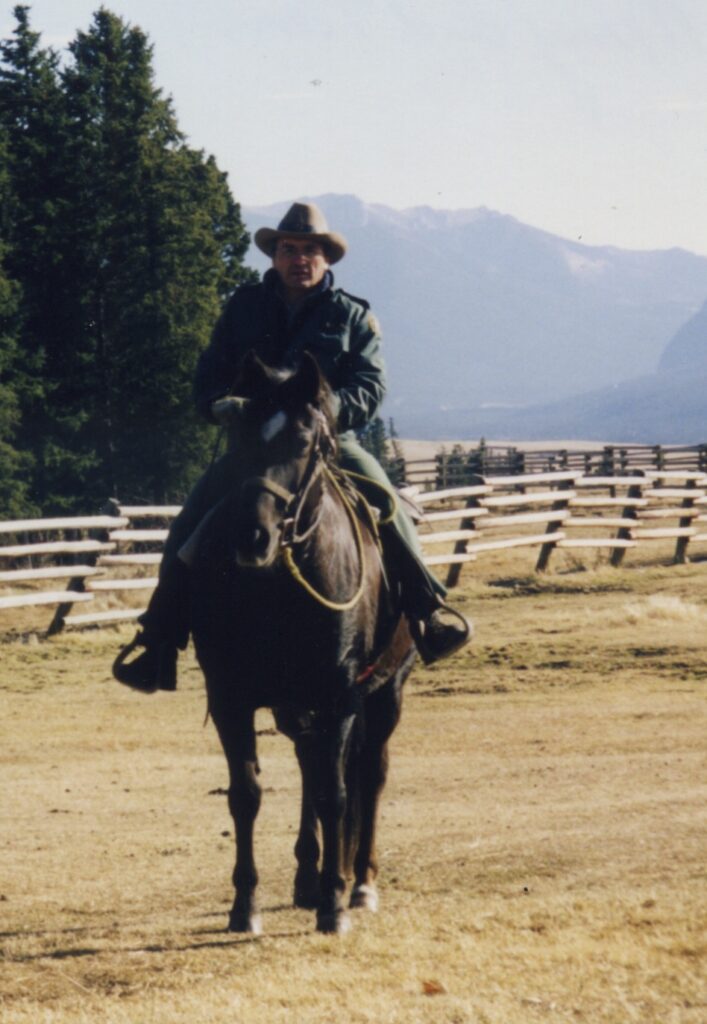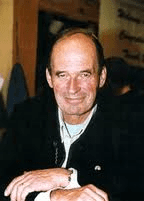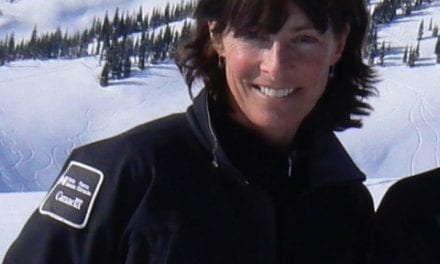Thank you to the Whyte Museum of the Canadian Rockies for granting permission to the Park Warden Service Alumni to post this interview on our website.
Park Warden Service Alumni Society of Alberta
Oral History Project Phase 10 – Summer 2020
Telephone Interview with Tim LaBoucane
September 3, 2020 – 11:00 am
Interviewed by Susan Hairsine
Place and date of birth?
Tim was born on February 7, 1950 in Rocky Mountain House, Alberta.
SH: Where did you grow up?
Tim: I moved from beautiful Alberta to southeast BC in the early 50’s. I have proof in the form of black and white photographs taken by my parents, of Kicking Horse Pass and other places where the roads were very primitive, nothing more than a goat track back in those days. So I grew up in southeast BC in various locations, Golden, Kimberley, lived in Windermere, etc.

Tim at the Ya Ha Tinda Ranch October 2002.
SH: How did you become involved in the Warden Service? Which national park did you start working in?
Tim: I was hired on the trail crew when I was going to college in Kamloops. I showed up for work and spent half the summer working on the trail crew and then there was an indigenous hire program that I became aware of, and I applied on that and got hired as a term Warden in Yoho.
SH: What year would that have been Tim?
Tim: Good question. That would have been around ‘76 I think, maybe ‘75, somewhere in there.
SH: So you started in Yoho as a term warden and what happened after that?
Tim: I spent several seasons there in terms of the summer and didn’t work in the winter as I was going to school. Then I applied on the seasonal competition and ended up with a seasonal job in Lake Louise, and worked at Saskatchewan Crossing with Alan Westhaver. Back when it was a pretty quiet place, but still enjoyable to work at.
SH: And very close to your birth place.
Tim: Yes, I made it out there actually once during that summer, but we were having such a good time working, Al and I, enjoying the summer, that we didn’t actually leave too much.
SH: So that summer would have been 1980 correct?
Tim: That’s right …. ‘79 or ‘80, somewhere in there.
SH: What made you want to join the Warden Service?
Tim: Working on the trail crew I saw these very interesting guys with cowboy hats on, cruising around doing a variety of things. They were out in the backcountry, on foot and on horse, they were responding to public safety, visitor safety related incidents with a fair degree of professionalism, and they also worked with wildlife and seemingly resource management duties also, and I thought that looks interesting. So I thought that would be a good thing to do and that’s what got me interested. Tape 4:22
SH: What different parks did you work in? How did they compare? Do you have a favorite?
Tim: I worked in Yoho, Banff and in Mount Revelstoke/Glacier.
SH: How do they compare, and do you have a favourite?
Tim: I would say the favourite over the years was Banff. There was an interesting rotation of duties in Banff, as you’d likely recall, as you were there about the same time as I was. So you rotated through a variety of frontcountry roles, backcountry, public safety, fire, resource management. And part of public safety in those days was also avalanche control. The dreaded winters at Sunshine, six months long. So there was a good variety of duties, and it was a very interesting place to work. Good people to work with and a fairly close-knit team I would say. Dispatch hadn’t quite arrived into the twentieth century until you came along.
SH: Ah, you’re sweet.
Tim: It’s true though. With regards to responsibilities ….. So, we just rotated through those programs and there were really good people to work with, interesting people to work with, like Tim Auger, etc. It was a more enjoyable place to work.
SH: What made you decide to go to Mount Revelstoke/Glacier Tim?
Tim: There was an opportunity to become a GT 3 or GT 4, something like that and it was more of a supervisor role, and it was a lower cost of living in Revelstoke, and it looked like it would be an interesting place to work. My then wife could get a job as a teacher, which was also important, because there wasn’t much of that in Banff or Canmore, so we decided to move.
SH: Okay, but when were you in Banff as I recall, you were running the fire program were you not?
Tim: I think I was in those early years, yes. I think what had happened was that Alan Westhaver had moved on, he was running it before me, and then I believe Cliff (White) before Alan. And then there was just a turnover in staff and Cliff became more responsible at a national level. Alan might have gone to Jasper to run the program up there, though I’m not quite sure.
I did a few seasons. I can’t remember how many. Those were in the initial years of the prescribed fires so I worked quite closely with Cliff, and those were also the initial years of the Incident Command System, which worked quite well over the years. There was lots of collaboration working with Wardens from other parks, which was good.
SH: I remember you were Ian Pengelly’s boss when I came there. You remember that guy.
Tim: Yes, I know that guy. I haven’t thought about that part of the fire program in that context for quite a long time. Ya. (Tape 7: 34)
SH: Great. So this is our story part. What are some of the more memorable events of your Warden Service career?
Tim: Well you know, I think that in the later years of change, there was not the good will of the Warden Service culture that had existed in the beginning and mid years, and that kind of overshadows things. But anyway, the good things about being a Warden in the early years was that you did have quite diversive duties in the various programs, as I mentioned earlier, but you were also outside a lot working within those various duties, so you weren’t stuck in the office which was nice. You could be outside a lot, outdoors, lots of field time, it was great. Good people to work with, a variety of duties, you got to hike, you got to use horses in the backcountry, lots of good mentorship, and you got to work on interesting projects from time to time. So overall it was a very interesting place to work.
SH: Can you tell me about any rescue/wildlife/enforcement stories that stick out in your memory?
Tim: I’ll mention one that comes to mind. It was quite funny. It had been a pretty dry spring, this is in fire management and I was working for Cliff White. Mark Heathcott was the crew boss on the fire crew and we were doing a planned ignition ….. a prescribed fire in the Lake Minnewanka area. Alberta was fully manned up because it was a pretty dry spring. They were in high hazard and they were quite shocked when we said we were going to do a prescribed fire. We had one of their senior fire officers come out, Kelly O’Shea. He was kind of a aghast at what we were going to do but was very professional, and he offered some good advice. The fire got very, very hot and it did a couple of great runs. We were all rather surprised by the behavior but it was good to see us working as a team. Byron Irons was there, there was a whole bunch of the mountain park fire guys in on this one. But it was a very memorable event in terms of being one of the big planned ignitions for the Warden Service. Overall it was very good but it was still …. A very good sense of team work but surprising the way the fire behavior went, let’s put it that way, in my year’s later recollection. Didn’t do a lot of damage but …. It went fast and hard.
That kind of continued not only with that one but with other fire managers in subsequent years, within the same park actually, and other parks. But the good thing was there was a review process established which was a good consensus building, post fire review that we all learned from for the most part. Not to say that some mistakes weren’t made in the future. But anyway, that was just one of the things that stand out now. It was a good team atmosphere, a lot of collaboration, a lot of good work together.
SH: Did you ever do fires in other parks or just Banff fires?
Tim: I was involved in those early years, with exports to other parks, and did some in Jasper and down in Waterton working with Randy (Schwanke). Yes there was a fair amount of moving around in those early years, so that was good.
SH: Good people in those other parks as well
Tim: Yes, I was involved in those early years with exports to other parks and I did some in Jasper, down in Waterton working with Randy. So yes, there was a fair amount of moving around in those early years which was good.
SH: Yes, good people in those other parks too.
Tim: Yes, people were very willing to work together. Everybody believed in the program and believed in the mandate in the parks. Those were the years before the big changes came. The way the changes were handled at a national level, going down to the field. All the secrecy and all the negativity changed that over time, sadly.
SH: Did you do fires in Mt Revelstoke/Glacier at all Tim?
Tim: Yes, we had a small program there. I was the Fire Management Officer …. whatever the term was back then in addition to being the Supervisor of the programs there, so I still continued to be involved in fires but not necessarily at the fire command team level. (Tape 12:29)
SH: Okay well you must have other stories ….
Tim: I have one wildlife story I’ll talk about, and you may have heard this one from other people. So, this was the days of the changeover of the Wardens that got hired post World War II. I can’t remember their names but you know Larry Gilmar was around then, there were several names that I can’t remember but these were the days when there were a lot of problems with bears in Banff. They had just changed over from the open dump system in the Cascade, to containing all the wet garbage behind a steel fence in the Banff Compound. So the bears moved in towards the townsite and there were quite a few bear problems. There were a couple of older wardens working on bears, I can’t remember their names. it wasn’t Rick Kunelius, it was a guy Rick Kunelius used to hang around with …. Can’t think of the names now. But anyway …. so it was when the big 747 pound black grizzly bear had attacked a person in the Forty Mile Creek wetlands next to town, and that person actually died. Before that no one had been trapping bears (using snares) in Banff so they brought in a couple experts on snaring and so they’d set up a snare and they eventually caught that bear and it was shot by Lance Cooper.
But associated with that Monte Rose had decided to continue with the trapping program, with permission, but more or less on his own, so he had several traps set up in the Cascade area, on the fire road, where the dump site had been for many years. And you were supposed to check the traps on a frequent basis, but he didn’t. So, he went back the next morning and there was a grizzly snared in the snare trap. What he didn’t know was the bear had chewed through three quarters of its way through the cable. So he went back to the office and said “I need some help.” So he grabbed Tim Auger, and Dan, I forget Dan’s last name, Perry Jacobson, and what was the name of the horse …. John …
SH: Nylund



